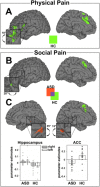Evidence from pupillometry and fMRI indicates reduced neural response during vicarious social pain but not physical pain in autism
- PMID: 26367817
- PMCID: PMC6869621
- DOI: 10.1002/hbm.22949
Evidence from pupillometry and fMRI indicates reduced neural response during vicarious social pain but not physical pain in autism
Abstract
Autism spectrum disorder (ASD) is characterized by substantial social deficits. The notion that dysfunctions in neural circuits involved in sharing another's affect explain these deficits is appealing, but has received only modest experimental support. Here we evaluated a complex paradigm on the vicarious social pain of embarrassment to probe social deficits in ASD as to whether it is more potent than paradigms currently in use. To do so we acquired pupillometry and fMRI in young adults with ASD and matched healthy controls. During a simple vicarious physical pain task no differences emerged between groups in behavior, pupillometry, and neural activation of the anterior insula (AIC) and anterior cingulate cortex (ACC). In contrast, processing complex vicarious social pain yielded reduced responses in ASD on all physiological measures of sharing another's affect. The reduced activity within the AIC was thereby explained by the severity of autistic symptoms in the social and affective domain. Additionally, behavioral responses lacked correspondence with the anterior cingulate and anterior insula cortex activity found in controls. Instead, behavioral responses in ASD were associated with hippocampal activity. The observed dissociation echoes the clinical observations that deficits in ASD are most pronounced in complex social situations and simple tasks may not probe the dysfunctions in neural pathways involved in sharing affect. Our results are highly relevant because individuals with ASD may have preserved abilities to share another's physical pain but still have problems with the vicarious representation of more complex emotions that matter in life.
Keywords: autism spectrum disorder; embarrassment; empathy; social complexity; social neuroscience; vicarious emotions; vicarious physical pain; vicarious social pain.
© 2015 Wiley Periodicals, Inc.
Figures




References
-
- Abell F, Happé F, Frith U (2000): Do triangles play tricks? Attribution of mental states to animated shapes in normal and abnormal development. Cogn Dev 15:1–16.
-
- American Psychiatric Association (2013): Diagnostic and statistical manual of mental disorders. Arlington, VA: American Psychiatric Publishing.
-
- Aoki Y, Yahata N, Watanabe T, Takano Y, Y Kawakubo, H Kuwabara, et al (2014): Oxytocin improves behavioural and neural deficits in inferring others' social emotions in autism. Brain 137:3073–3086. - PubMed
-
- Baron‐Cohen S, Jolliffe T, Mortimore C, Robertson M (1997): Another advanced test of theory of mind: Evidence from very high functioning adults with autism or Asperger syndrome. J Child Psychol Psychiatry Allied Discip 38:813–822. - PubMed
Publication types
MeSH terms
LinkOut - more resources
Full Text Sources
Other Literature Sources
Medical

